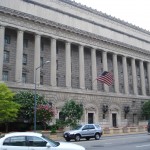Jun 28 2010
United States Department of Commerce, International Trade Administration
This summer I find myself in our nation’s capital amidst the grandeur of American symbols and in the seat of democratic power. But beyond the sights and sounds there is work to be done.
My desk for the summer does not sit in a law office or a judge’s chambers, but rather in the Herbert Clark Hoover Building: home to the United States Department of Commerce (DOC).
For those new to federal administrative law, DOC is an executive agency within the US government and is directed by Secretary Gary Locke. President Obama appointed Secretary Locke with the advice and consent of the Senate to carry out his trade agenda within the mission of the DOC to make American business more innovative and competitive in a global marketplace. The DOC’s broad mandate, codified as 15 U.S.C. § 1501 et seq., is to advance economic growth, engaging in areas of trade, technology, and entrepreneurship.
As is common with federal agencies, the DOC is comprised of several sub-agencies, each with a special area of expertise. Among them is the International Trade Administration (ITA), responsible for strengthening competitiveness of US businesses, promoting fair trade and investment abroad and at home, and enforcing our trade laws and international agreements.
ITA has four units, again divided into specialties: US and Foreign Commercial Service; Market Access and Compliance; Import Administration; and Manufacturing and Services (MAS), home to my office, Heath and Consumer Goods. Among the aims of MAS is to ensure US industries’ input into international trade policy and regulation and to help reduce the costs borne by such law, with my office focusing on the pharmaceutical and health device industries. The Health Products and Technologies team participates in trade negotiations and the development of US trade policy with the ultimate goal to be a system of trade law and public policy that enhances the competitiveness of health industries at home and abroad.
It is within this administrative framework that I address a complex and developing issue: how will international intellectual property regimes, particularly those of the U.S., Brazil, India, and China, apply to the coming surge of biosimilars into the global pharmaceutical marketplace and how will U.S. trade policy affect the important and sometimes competing interests of IPR protection and access to medicines?
- US DOC



